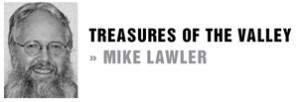Yeah, you heard me right. There’s a gang of winos hanging out in Deukmejian Park.
“We’re not ‘winos.’ We’re ‘wineaux’!” says Stuart Byles, president of the newly formed Stonebarn Vineyard Conservancy. Their goal is to celebrate the historic practice of vineyard cultivation and winemaking in the Crescenta Valley. The Conservancy, in cooperation with the City of Glendale’s Parks Department, is maintaining the vineyard, harvesting the grapes, and for the first time in nearly 90 years, making wine at the heritage vineyard next to the century old Le Mesnager Barn in Deukmejian Wilderness Park.
The history of vineyard cultivation is strong locally. The first non-Mission vineyards were planted by our own Don Jose Verdugo in 1790. Later, when Dr. Benjamin Briggs founded La Crescenta in the 1880s, one of the first crops he planted in the rocky soil were grape vines brought from Persia. Grapes were a natural choice for cultivation on the alluvial slopes of CV, with its dry Mediterranean climate, and early landscape photos of the valley show vineyards everywhere. The area attracted French, Italian and German immigrants who brought their native winemaking culture with them, and ads for “Fine La Crescenta Wines” can be found in turn of the century Los Angeles newspapers.
The Le Mesnager family was part of the migration to our valley in the late 1800s, and George Le Mesnager and son Louis established large vineyards in Verdugo Canyon, Sparr Heights, and the land that is now Deukmejian Park. According to most records, they built the huge stone barn, now a centerpiece of the park, in 1915 and used it as a storage site for the grapes before they were hauled to the family’s winery in downtown Los Angeles. The business folded with the enactment of Prohibition, and the family moved into the barn, continuing to grow table grapes, and wine grapes for “personal consumption.” The barn and land around it was bought for a park by Glendale in the ‘80s.
When Park Project Manager John Pearson designed the park, he insisted there be a “demonstration vineyard” next to the stone barn, which would eventually house a small winemaking museum, as well as the planned community center. After the demonstration vineyard started producing, locals began to take an interest in producing wine from the grapes and, encouraged by the City, the Stonebarn Vineyard Conservancy was formed. They’ve learned as they’ve gone along, and last year was probably their best year. They hosted several public events centered on maintaining the vineyard, capped off one hot day last fall by a harvest festival. Attendees picked the grapes and put them through a 100-year-old hand-cranked crusher. In the evening, the participants, many with their hands stained a dark purple, enjoyed dinner and a wine-themed movie-in-the-park on the City’s outdoor movie screen.
More such events are planned by the Conservancy this year, along with some improvements in the vineyard. The trellises will be heightened, and some grafting of the established vines is also proposed. This is all a learn-by-doing hands-on experience, and the community is encouraged to join in. A $40 donation gets you a membership in the Stonebarn Vineyard Conservancy, and supports the costs of the winemaking and vineyard cultivation, which is currently being borne by the Historical Society of the Crescenta Valley. Once a member, you have an inside track on their schedule of bottling and labeling parties and wine tasting events, as well as the knowledge you are supporting the heritage of our community. If you’d like to participate, give Conservancy President Stuart Byles a call at (818) 249-2414.
The Stonebarn Vineyard Conservancy, along with the City of Glendale is also putting on a series of classes on vineyard cultivation and home winemaking. The first class is coming up in a week, on Saturday, Jan. 22 at 9:00 a.m. at Deukmejian Wilderness Park Vineyard, 3429 Markridge Road, and will cover vineyard overview and history, pruning for premium growth, and grafting.
I’ll see you at the classes. I’ve always wanted to be a wineaux!

